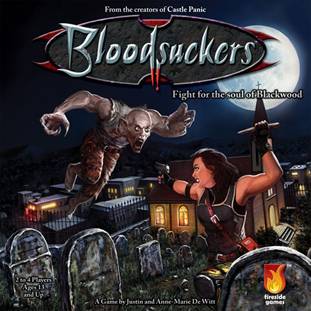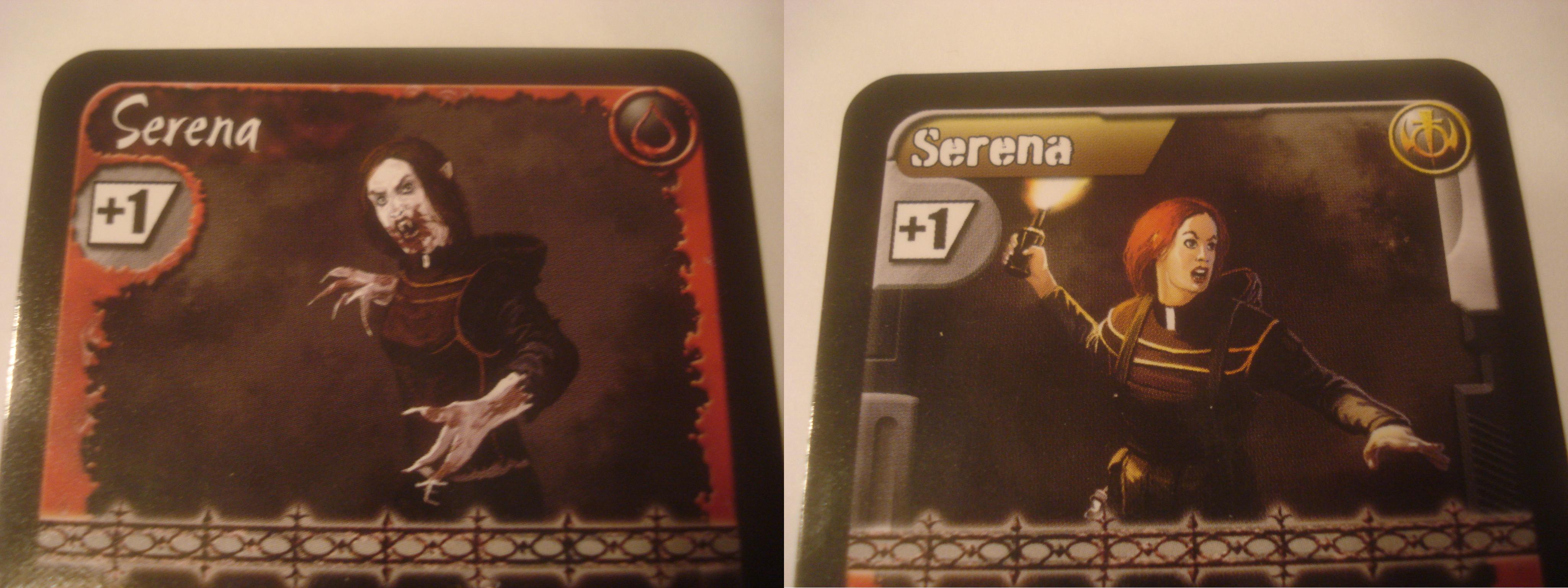| Publisher | Fireside Games LLC |
| Design Credits | Justin De Witt and Anne-Marie De Witt |
| Art Credit | Yoann Boissonnet |
| Game Contents | One town board, one guide mat, 51 vampire combat cards, 51 hunter combat cards, 32 character cards, four reference cards, 10 vampire attack tokens, 10 hunter attack tokens, six adrenaline tokens, six blood tokens, 20 action counters, six-sided die, rules |
| Guidelines | Vampires vs. hunters team combat game |
| MSRP | $39.95 |
| Reviewer | Andy Vetromile |
With a name like Blackwood, this town probably hasn’t had a very summery history. To add cachet to the imposing name, vampires have moved into this idyllic setting and things are looking downright grim for the poor populace. On the plus side, hunters have followed their prey here and are prepared to take them on, and so begins the board game Bloodsuckers.
The object of the game is to control the most buildings in Blackwood at the end of the game.
Two to four players take on the roles of vampires or the hunters thereof, working in teams if there are three or four participants. Everyone gets a set of character cards, a hand of combat cards, and tokens to track information. The characters are the players’ agents in Blackwood – turn Dmitri’s card one way and he’s human, turn him to show the other end and he’s been transmogrified into one of the undead. Flip it over to its other side and the character is just a bystander caught up in the violence. The town comprises five locations such as the graveyard, nightclub, and police station, and each of these has from two to five bystanders. These characters have yet to ally with anyone and merely represent the struggle for that building. The “board” has a series of dials, one for every location, and each shows which places are contested and which have fallen to one side or the other.

Blackwood: The nightclub is on fire - no, really on fire - and something's wrong in the hospital's radiology department
A sixth dial tracks the rounds of combat. Fights starting at dawn favor the heroes while the vampires, er, “shine” at dusk. The guide mat is a strip across the middle of the table, with members of the two factions facing each other across it. The columns contain bystanders and there is space to place vampire and hunter character cards. The two blocs alternate taking actions; moving characters from one column to another; playing combat cards like Shotgun, Holy Water, and Pounce; and using character abilities (e.g., reroll a die, switch characters, or draw another card) to get the highest total in each column. There’s a combat track on the back of every bystander where attack counters for both sides record their scores. (A bystander can’t use his character ability but it’s on the card back so you know who to recruit.)
When the combat dial finishes one full revolution, that fight is over. Each bystander joins the team that scored the highest in their combat, and whoever “recruited” the most bystanders wins that location. One location down, four to go . . .
The board artwork is wonderful, if not a little too hopeful (every location’s lights aren’t just on, they’re blazing – except the graveyard, but that’s the church’s backyard so the unquiet dead won’t have any trouble finding their way in the dark). Character portraits are spotty; the paintings offer little variation at this resolution, and on the vampire end everyone looks more like emaciated meth addicts than creatures of the night. More care is given to their human presentation, and they do a nice job of varying the poses and weapon loadouts for each illustration. The two card ends do favor each other (save perhaps Serena, who goes from a redhead to a washed-out brunette when she turns undead). The art on the hunters’ combat deck seems better than the vampires’ – the humans have dramatic pieces while attempts at dynamism on the vamps’ cards seem comic-bookish and a little out of place for the overall feel. The cardstock isn’t impressive; the turn-reference cards use identical material, but they’re bigger and broader than combat cards so confidence in their resilience is even lower.
The guide mat for the bystanders (one of those annoying fold-up displays that won’t stay flat until you back-fold it and stack salt shakers and other bric-a-brac on the corners) is brightly colored and spacious, and looks like it can take serious punishment while resisting even the biggest Mountain Dew spills. It also looks big enough to accommodate the combat tracks, which would save piggy-backing them on each character card. Adrenaline and blood tokens, for boosting hunters’ actions and vampires’ combat scores respectively, are pretty gems, and the action tokens (surprisingly gay for such a dark game) are nice and meaty. Then there are the attack counters – they have to be small to fit on the bystander combat tracks, but their size still makes them bothersome. The board is really a display for the status of town locations and the current combat round, and much like the hindside of a picture frame that stands on your table, it has foldout “legs” so it’s upright where players can see it. Unlike that frame, you’re supposed to alter and spin little dials on this one all game long, and that’s when the idea’s limitations become clear. It helps to steady it on felt or newsprint or some other textured surface in lieu of a smooth tabletop, but really the result is the same: You get tired of fiddling with it, lay it flat on the playing surface, and use it there.
Bloodsuckers makes subtle but powerful use of a few simple mechanics. Combat boils down to moving characters and initiating fights with cards, but within that abstract framework there is space for a good bit of strategy that keeps things interesting. It forgoes the tendency of some games to rack up a lot of combat points – using a shotgun, for example, doesn’t add to your use of a pistol, it simply replaces one combat value with a slightly higher one – and while the numbers haven’t much range (most hunters’ weapons are valued two through five), other cards may change those numbers in small but meaningful ways. Impact cards produce surprises everywhere, strike cards facilitate fast assassinations, and character abilities make choosing both combatants and targets an important tactical consideration; combat results become uncertain but remain balanced.
The rules could use more page references, and variety in the cards would be welcome (over 102 combat cards there are only 34 different ones). Town locations vary only by the number of bystanders they offer unless you use one of the variant rules. Still, that fertile ground is what supplements are for, yes? There are spots where the rules could be clearer: For example, you cannot play attack cards for or on your teammate but the sub-machine gun adds to ALL current Hunter attacks (their emphasis), and though you must commit at least one character every time there’s a battle, it’s not clear if one card is enough for both players during team play. Most such bugs are squashed by a pretty complete set of instructions, and such ambiguity is usually but a distant relation.
So while Bloodsuckers has a few missteps to it, most of them are superficial and won’t get in the way of serious gaming. Once the players have the pattern down, the bite-sized bits of cunning that can make or break a battle become more obvious and the war against the vampires, more conceptual than tactical, takes on an unlife of its own.


